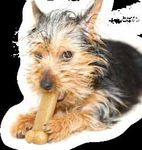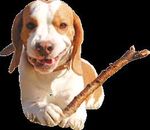Reward-based training: a guide for dog trainers
←
→
Page content transcription
If your browser does not render page correctly, please read the page content below
Reward-based training:
a guide for dog trainers
The Australian Veterinary Association (AVA) recommends
the use of positive reinforcement training methods
for dogs as the preferred method of training.
Introduction
The use of positive punishment (applying something the dog doesn’t like to make
behaviour less likely to occur in the future) is often a first approach used in dog training
and for modifying problems in behaviour. However this method is not preferred by most
behavioural specialists as dog training techniques that a dog doesn’t like can be dangerous
for both owners and dogs.
How dogs learn
It’s important to recognise that learning some responses are due to learning.
is an adaptive process used by a dog to The consequence of this response will
cope with a changing environment. When influence the likelihood of the behaviour
there is a change in the environment the occurring again.
dog will respond physiologically or with a
In many ways dogs learn the same way
change in behaviour.
we do, by making connections between
Some responses are instinctive (such as neurons. Pathways are strengthened
a newborn pup seeking a nipple), some through repetition and are weakened
responses are due to the environment through lack of use.
(such as drinking when thirsty), and
Classical conditioning is an involuntary process that the dog, the behaviour
happens when a dog makes an association between a is likely to decrease in frequency.
previously “neutral” object (such as a set of car keys) and Dogs, like all animals, learn to respond
a reflexive action or emotional response (such as the to stimuli that enhance the possibility
excitement of the possibility of going to the beach). The of a good outcome.
dog has no control over its behavioural response. Rewarding means that the dog
Instrumental conditioning takes place when an receives something it wants,
association is made between a neutral stimulus (such or values, as a consequence of
as the word “sit”) and a voluntary response (placing its behaviour. These are called
bottom on ground). This type of behaviour is modified “reinforcers”.
by the consequence of the dog’s Primary reinforcers are essential for survival,
response. For example, if the such as food, water and reproduction. Secondary
consequence is rewarding, reinforcers are neutral things such as words which have
the behaviour is more likely been associated with primary reinforcers to become
to increase in frequency. If the desirable to the dog. For example, the words “good dog”
consequence of the chosen or the sound of a clicker means nothing to a dog until the
behaviour is unrewarding to dog has associated it with a treat for example.Punishment as a training method
Punishment uses the principle that if the consequence is painful or unpleasant, the dog is
less likely to behave that way again. This can involve two strategies:
Positive punishment is applying something the dog doesn’t like to make the behaviour
less likely to occur again. For example, smacking a dog on the nose (an aversive stimulus)
when it approaches to take a biscuit off the table reduces his scavenging behaviour around
the table.
Pitfalls of positive punishment
• Positive punishment has to • It’s likely to increase anxiety in • Punishment may be used as
be delivered immediately dogs (Schilder 2004, Overall a substitute for losing one’s
and consistently and be of 2007). temper and lashing out.
the appropriate intensity to
• It can lead to defensive • Punishment may elicit a strong
be effective in reducing the
aggressive behaviour in many fear response and this response
likelihood of a behaviour
species of animals, putting can generalise to things that
occurring (Overall 2006). This
the person administering it or sound or look similar to the
can be very difficult to achieve.
any person or animal near the punishment.
• It stops a behaviour but fails dog at risk of being bitten or
• Learned helplessness can
to replace it with a desired attacked (Hetts 1999).
develop (i.e. depression,
behaviour, thus creating a
• Animals can habituate to learning problems,
“behavioural vacuum”.
punishment so the owner may decreased motivation)
• The dog doesn’t learn what is feel the need to escalate the (Lindsay 2000).
“right” or what is wanted from intensity of the punishment or
• It doesn’t support
him. to cause physical injury in order
a healthy human-
to be effective (Landsberg 2005).
animal bond.
Negative punishment means taking away something the dog wants to make the behaviour
less likely to occur again. For example, removing all biscuits from
the table as the dog approaches the table (removal
of something the dog wants) reduces the likeli-
hood of the dog scavenging around the table.
Reinforcement as a
training method
There are two types
of reinforcement techniques
Positive reinforcement involves
giving the dog something it wants to make the behaviour more likely to occur again.
This occurs if asking the dog to sit and stay and giving it a reward (something the dog wants)
for staying away from the biscuit on the table increases his likelihood of doing as asked again.
Negative reinforcement involves removing something aversive to make the behaviour more likely to occur again. This
occurs if holding the dog back from the table by a tight choker chain (an aversive stimulus), and releasing the pressure
when the dog sits down and stops leaning in towards the biscuits. This results in the dog being less likely to try and
approach food on the table in the future. Note that an aversive stimulus had to be present (the choker) for the dog to
have to work to escape, so negative reinforcement can also be called escape or avoidance learning.
The use of positive reinforcement is the most humane and effective training method as it avoids undesirable
behavioural side effects. It also makes training more enjoyable and helps to improve the bond with the pet.Problems with using punishment in training
Training methods that use positive punishment and negative reinforcement
have been linked with undesirable side effects for dogs and behavioural
problems such as escape and avoidance behaviour (to avoid the
punishment), aggressive behaviour (in self-defence), response
suppression (habituation or learned helplessness) and fear of people
or things in the environment where the aversive stimulus was present (fear
conditioning and generalisation). (Blackwell 2008)
Further information about encouraging positive behaviour in dogs
It’s much better to prevent behaviour problems than modify them. Behaviour is the result of the interweaving of genetics,
learning and the environment.
Breeding from dogs with good temperaments is one way of reducing the likelihood of some behavioural problems,
although “genetics influence the probability of a behaviour, rather than controlling it in an iron-clad way. Both genes and
environment impact on the formation of temperament and the expression of behaviour.” (Carter 2009)
It is quite clear that puppies benefit from appropriate (meaning positive and harmless) socialisation. This has been
shown to decrease inter-dog reactivity and fearfulness of people, places and situations. (Lindsay 2000, Pageat 2007)
If they are deprived of this contact (as in some kennels or refuges) during the critical period for socialisation, there can be
severe long-term effects on the ability of the pet to live successfully in a family environment. These dogs are more likely to
develop antisocial behaviour, and many will eventually be referred to animal
behaviourists or contribute to the number of unwanted problem dogs.
(AVA policy 6.11)
The first 16 weeks of life are a critical learning period for puppies.
During this time, social and behavioural patterns are
established. For optimum socialisation, it is essential
that puppies have regular social contact with
humans, with other dogs and with the
mother and littermates.
Puppy classes are one of the most important services veterinarians can offer
clients and their puppies to ensure effective continuation of socialisation. Pups
attending puppy classes should be healthy, have received their first vaccination,
and the environment should be thoroughly clean. (Seksel 2009)
Helpful advice for dog owners
Other strategies to modify behaviour include
giving advice and help to owners such as:
• Seeking the help of a • Having the dog medically checked • Seeking further advice from a veterinary
qualified trainer who by a veterinarian to rule out any behavioural specialist or veterinary behaviourist
uses reward-based underlying medical problem that if required so that a diagnosis can be established,
training techniques. might be contributing to the and a behavioural modification plan can be
undesirable behaviour. tailored to the dog’s needs.Examples of reward based training techniques
Behaviour: Pumpkin growls and bites her
Behaviour: 3
owner’s hand when she has her harness
1 Sassy jumps up to Behaviour: Fred likes to sit put on. The owner has tried pulling her
greet people: her 2 on the kids’ artwork when they hand away, saying “no” and smacking Pumpkin. The
owners have tried pushing have it sprawled on the floor problem is getting worse and Pumpkin is biting
her down and kneeing her for colouring in, and often chews on sooner and harder.
to knock her off balance the textas. They have tried pushing Training technique: The owner should consider
when she jumps. This has him away, saying “no” and chasing him trying a collar instead of a harness, to remove
not worked, in fact she when he chews on their textas. the source of the problem and start a program
now jumps from further Training technique: Fred can be of counterconditioning and desensitisation to
away to avoid the knee. lured onto a special mat or cushion the harness. This involves giving Pumpkin treats
Training technique: with food and rewarded when he gets whenever she sees the harness (a distance away
Sassy should be ignored on the mat. When he takes a texta from her that does not cause her to growl).
if she jumps and only they can ask him to come to them, Gradually the harness can be brought closer, with
receive attention sit and then swap the texta for a tasty treats given for calm, non-fearful behaviour from
(including eye contact) treat or chew toy. Ultimately they can Pumpkin. With correct timing and much repetition,
when she has four paws treat him to “go to bed” and to “give”. Pumpkin will associate the harness with treats and
on the ground. Only when Fred can be trained to go to his mat be happy to see the harness. In tiny increments,
she is standing or sitting and stay there using lure and reward the harness is brought closer and closer and
should she be rewarded methods that will gradually build the eventually placed on Pumpkin. Pumpkin can also
with attention and treats. duration he can remain settled there. be taught with treats to enjoy being handled.
Summary
Animal welfare is paramount when training animals. It is part of the duty of care
society owes each animal whose behaviour we seek to change. Reward-based training
should be used as the primary method of training because of the benefits it offers.
References
Australian Veterinary Association; policy OF CHILDREN: Converging Evidence From McGreevy P D and Boakes R A (2007): Schilder, MBH and van der Borg JAM,
Compendium: http://www.ava.com.au/ Social Science Research and International Carrots and Sticks. Principles of animal (2004): “Training Dogs with the Help of
about-us-1. Accessed 8th August 2011 Human Rights Law and Implications for training. Cambridge University press the Shock Collar: Short and Long Term
Blackwell EJ, Twells C, Seawright A, Casey U.S. Public Policy. Psychology, Public Policy, pp25-62 Behavioural Effects” in Appl. Anim. Behav.
RA. (2008). The relationship between and Law, Volume 13, Issue 4, November Overall, KL. (2006): Understanding how Sci. pp 319-34
training methods and the occurrence 2007, Pages 231-272. dogs learn: Importance in Training and Seksel K (2009). Why are puppy and kitten
of behaviour problems, as reported by Hetts S. (1999). Pet Behaviour Protocols. Behaviour Modification. In: World small classes important to your practice? NAVC
owners, in a population of domestic dogs. What to say, What to do, When to refer. animal veterinary association world Conference Proceedings (North American
J VetBehav 3, 207-217 AAHA Press p 178 congress proceedings, 2006 Veterinary Conference) Jan 17 .
Carter G. 2009: Genetics and Behaviour Horowitz D, Horowitz A (2008). A Overall, KL (2007): “Editorial: Straus M A, Donnelly D A, (2001).
in dogs: Implications for Breed Specific comparison of Dog Owner’s Claims about Considerations for Shock and “Training” Beating the Devil out of them. Corporal
Legislation. Presented at the Dog Bite their Pet’s Guilt with Evidence from Dog Collars: Concerns from and for the Punishment in American families and its
Symposium presented by Australian Behaviour. Proceedings of the Canine Working Dog Community” in J. Vet. Behav. effects on Children. Transaction Publishers,
Veterinary Behaviour Interest Group, Science Forum 2008, Budapest, Hungary : Clinical App Res 2 2007. p 103-107 New Jersey pp3-4
Darwin Convention Centre, May 2009. Landsburg G, Hunthausen W, Ackerman L Pageat P (2007). Preventing Behaviour Further reading:
Farm Animal Welfare Council (U.K.) (1997): Handbook of Behavior Problems of problems in Puppies: Current Techniques http://www.avsabonline.org/avsabonline/
website the Dog and Cat, Elsevier Saunders, p101 in Veterinary Practice. In: SEVC images/stories/Position_Statements/
http://www.fawc.org.uk/freedoms.htm. Lindsay SR (2000). Handbook of Applied Proceedings 2007. Southern European Combined_Punishment_Statements.pdf
Accessed July 2011 Dog Behaviour and Training. Vol 1, Iowa Veterinary Conference (Eds). Publisher:
SEVC (www.sevc.info). Internet Publisher: http://www.avsabonline.org/avsabonline/
Gershoff E T, Bitensky S H, (2007). THE State University Press. images/stories/Position_Statements/
CASE AGAINST CORPORAL PUNISHMENT International Veterinary Information
Service, Ithaca NT (www.ivis.org). dominance%20statement.pdfYou can also read


























































